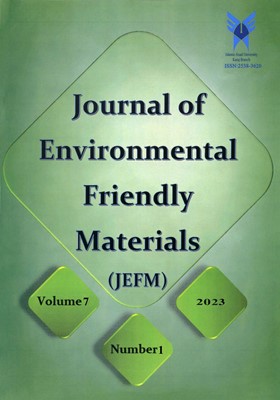Evaluation of Corrosion Behavior of 316 L Stainless Steel Manufactured by SLM Method After Heat Treatment and Surface Treatments
محورهای موضوعی : Journal of Environmental Friendly MaterialsS Abdulnabi Wali 1 , M Razazi Boroujeni 2 , S Nosohiyan 3
1 - Department of Materials Engineering, South Tehran Branch, Islamic Azad University, Tehran, Iran
2 - Department of Materials Engineering, Lenjan Branch, Islamic Azad University, Isfahan, Iran
3 - Faculty of Skills and Entrepreneurship, Isfahan Branch, Islamic Azad University, Isfahan, Iran
کلید واژه:
چکیده مقاله :
In recent years, selective laser melting (SLM) has attracted the attention of engineering active in this field due to its controllability, the possibility of producing parts with complex shapes and good surface properties. It has been found that by performing the next operation that takes place after the production of parts by SLM method, its surface properties such as corrosion and tribological properties can be improved. In this research, two types of subsequent treatments including heat treatment and surface mechanical treatment (shot peening) were investigated on the microstructure and corrosion behavior of the 316L sample produced by SLM method. Examining the microstructure of the samples with the help of optical microscope images showed that surface treatment and heat treatment make the grains rougher and finer, respectively. The XRD pattern of the samples indicated the austenitic nature of the alloy produced by SLM method, which did not show any phase change on it by mechanical operation. While heat treatment caused the formation of oxide compounds such as chromium oxide. The corrosion behavior of the samples was evaluated using the cyclic polarization test. The results of this test showed the positive effect of the oxide layer formed during heat treatment on the corrosion behavior of the SLM sample. Also, the sample with both surface treatments showed the highest corrosion resistance due to having the lowest roughness and the presence of chromium oxide.
[1] C. Prieto, M. Singer, T. Cyders and D. Young, Corros., 75(2019), 140.
[2] J.R. Trelewicz, G.P. Halada, O.K. Donaldson and G. Manogharan, Jom., 68(2016), 850.
[3] D. Kong, X. Ni, C. Dong, L. Zhang, C. Man, J. Yao, K. Xiao and X. Li, Electrochim. Acta., 276(2018), 293.
[4] Q. Chao, V. Cruz, S. Thomas, N. Birbilis, P. Collins, A. Taylor, P.D. Hodgson and D. Fabijanic, Scr. Mater., 141(2017) 94.
[5] Y. Zhao, H. Xiong, X. Li, W. Qi, J. Wang, Y. Hua, T. Zhang and F. Wang, Corros. Commun. (2021).
[6] Kale, Amol B., et al., Mat. Char. 163(2020), 110204.
[7] Kong, Decheng, et al., Electrochim. Acta, 276(2018), 293.
[8] Ueno, H., et al., Acta. Mater., 59.18(2011), 7060.
[9] Lu, K., et al., Scripta. Mater., 66.11(2012), 878.
[10] Krawczynska, Agnieszka Teresa, et al., Materials & Design, 136(2017), 34-44.
[11] Wang, Di, et al., Rapid Prototyping J., (2016).
[12] Bernevig-Sava, M. A., et al., IOP Conf. Series: Mat. Sci. Eng., 572, 2019.
[13] Portella, Quentin, Mahdi Chemkhi, and Delphine Retraint, Mat. Char., 167(2020), 110463.
[14] Yin, Y. J., et al., Mat. Sci. Eng., 744(2019), 773.
[15] Chen, Hongwei, et al., Metals, 10.1(2020), 102.


